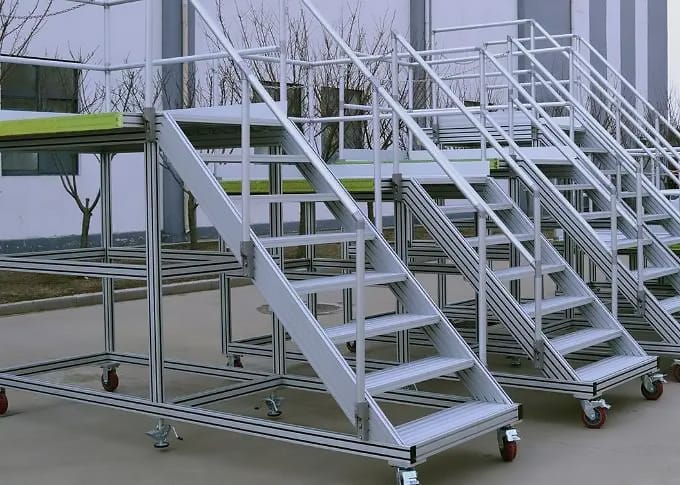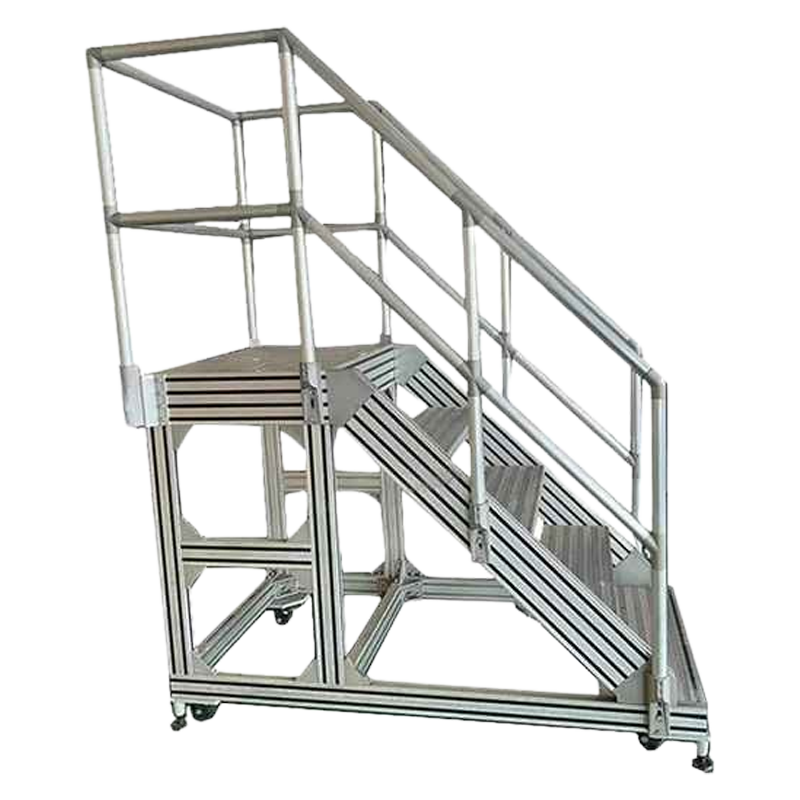Aluminum alloy ladders are a stellar choice for those seeking durability, versatility, and safety in their climbing equipment. Their cost-effectiveness and high load-bearing capacity, combined with the option for added mobility, make them an essential tool for a wide range of activities, ensuring high performance and reliability.
Description
Industrial Stairs and Platforms
The aluminum alloy ladders are different from other climbing ladders made of aluminum alloy light climbing ladders, PVC climbing ladders and other materials. We assemble It with industrial aluminum profiles. And is a heavy-duty climbing ladder with a load-bearing capacity that exceeds the weight of an ordinary person.
It would be a bit of a waste of money and cost if used in other places such as libraries and homes. But it is just right for use in workshops.

What is the Difference of Stainless Steel and Aluminum Alloy Ladders?
The distinction between stainless steel and aluminum alloy ladders is grounded in several factors such as composition, heft, structural integrity, resistance to deterioration, and cost.
- Composition: Ladders crafted from stainless steel typically use 304 or 316 grades, known for their robustness and hardness. In contrast, aluminum alloy ladders are composed of an aluminum alloy which is notably lighter and more malleable.
- Heft: Aluminum alloys being considerably lighter than stainless steel make the aluminum alloy ladders much more transportable and convenient for storage—a significant consideration for users who need to relocate ladders often.
- Structural Integrity: Ladders made of stainless steel boast enhanced strength and endurance, capable of supporting more substantial weight and enduring greater forces. On the other hand, the structural fortitude of aluminum alloy ladders is somewhat lesser, making them less suited for heavy-duty tasks or extensive use.
- Resistance to Deterioration: Known for its excellent resistance to corrosion, stainless steel effectively withstands rusting and degradation. Thus offering greater longevity in moist or particle-laden areas. Although aluminum alloy ladders also possess a degree of corrosion resistance, it falls short when compared to that of stainless steel.
- Cost: Generally, stainless steel ladders command a higher price tag owing to the more costly material and complex manufacturing techniques involved. Aluminum alloy ladders, however, are more budget-friendly and appeal to those with fiscal constraints.
In essence, each type of ladder—whether stainless steel or aluminum alloy—has its unique set of strengths and drawbacks. Stainless steel ladders are optimal for settings requiring enduring substantial weights and pressure along with superior corrosion resistance. Conversely, aluminum alloy ladders offer lightweight convenience for users requiring frequent mobility. The appropriate ladder selection should be based on the specific requirements and financial allotment of the user.
Classification and Analysis of Aluminum Alloy Ladders
1. Single-sided ladder
Single-sided ladder is the most common type of aluminum alloy ladders. We can not only use it against one wall during normal use and cannot hang on the ceiling. Or other uneven surfaces. Single-sided ladders are suitable for simpler operations such as smaller interior decoration and home DIY. And the price is relatively cheap.
2. Double-sided ladder
Double-sided ladder is a type of very practical aluminum alloy ladders. And we can use that against two walls at the same time. That is, we can operate it freely without finding a support point. The price of a double-sided ladder is relatively high, but its safety and reliability are higher. And it is suitable for people who have high requirements for ladder quality.
3. Folding ladder
The folding ladder is a type of aluminum alloy ladders that is easy to store. Its foldable design allows it to occupy a small storage space and does not require a large site to operate. Folding ladders are suitable for smaller operations such as daily household maintenance and DIY, and the price is relatively cheap.
4. Telescopic ladder
The telescopic ladder is a type of aluminum alloy ladders that can freely adjust the length and can be extended and retracted according to different scene needs. The price of the telescopic ladder is higher. But its use range is wider, suitable for outdoor work, such as decoration, construction projects and other occasions.
5. Other types
In addition to the above four types of aluminum alloy ladders, there are some other types, such as ray ladders, inclined ladders, etc.. But we use them less widely and relatively expensive, and are not common for most people.
In Conclusion
The industrial aluminum profiles are enveloped by an anodized layer surpassing 12 microns in thickness, rendering them remarkably resistant to both corrosion and oxidation. This contributes to an extended lifespan, coupled with the ease of cleaning and maintenance. Such durability and low upkeep make these ladders a more economical alternative to their iron counterparts.
Furthermore, aluminum alloy ladders boast a significant capacity for load-bearing, ensuring both high stability and a solid hardiness. Thereby permitting these aluminum alloy ladders to achieve greater heights when compared to those constructed from different materials. Additionally, the inclusion of Foma casters at the base provides the convenience of smooth mobility. It allows the aluminum alloy ladders to be effortlessly transported and securely positioned as needed.
Aluminum alloy ladders are very useful in workshops and are one of the basic facilities needed in workshops. Many workshops have two- or three-story steel platforms. And it is much more convenient and trouble-free to use aluminum alloy ladders for loading and unloading materials.





